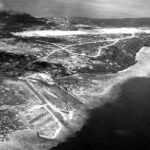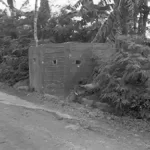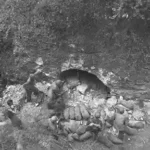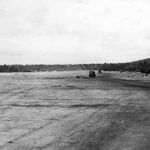CHamorus/Chamorros Forced into War Effort
Table of Contents
Share This
Land clearing, construction and much more
By early 1944, the CHamorus/Chamorros were mere tools to be utilized by the Japanese forces without regard to their safety or well-being. Most of the men were used to clear the land at either of the two operational air strips at Orote and Jalaguac (also spelled Kalaguac), or at one being developed at Ague, Dededo in the northeastern corner of the island.
Some of the younger men were utilized to help construct pillboxes and man-made caves. Still others were used to install real and dummy cannons at several coastal areas, and to transport food and ammunition to key defense outposts. The women were used primarily to plant and harvest farm crops though some did land clearing too. Children worked as well.
At the southern end of the island, Japanese soldiers – in desperation – ordered groups of CHamoru men to lay coconut tree trunks across the road, ostensibly to stop American tanks. In Asan, forced laborers constructed a tank trap consisting of trunks buried vertically and arranged in a maze-like pattern. Laborers also piled huge mounts or rocks along the beach, and dug massive holes in the sand in an attempt to block and disable enemy tanks.
Some CHamorus were directed to hunt and kill all dogs they could find, the rationale being that dogs gave away the presence of people.
Personal forced labor story: clearing the airstrip
Considering the circumstances under which the original landing Tiyan strip was built and its indispensability to the island’s future, it has attained memorial stature at least among those who wielded the primitive tools to build it. It makes a worthy companion to the latte stone which, interestingly enough, was also used as foundation stone, among others, by our ancestors.
The airport today dwarfs what we achieved during the occupation but it was built with earth movers, bulldozers, backhoe, and steamrollers. If, during the occupation, we had known the wonders that modern technology could perform, we might have said that what was being asked of us was impossible. And, having decided that, we might never have completed the airstrip. We would never have been able to overcome the psychological barrier that we would have created between us and the job’s completion.
There would have been nothing that the Japanese forces could do to make us get the project done. It would not be that we would have worked more slowly. In the actual construction, our lack of enthusiasm translated to a snail’s pace in any event. Rather, we would have been so daunted by our perception of the enormity of the task that we simply wouldn’t have been able to do it. Our naivete then worked to the enemy’s advantage. We got the job done simply because we didn’t know that we couldn’t!
As we were finishing the airstrip, it was not possible to simply dismiss it as something we were forced to do. Surprisingly, most of us looked at it with a kind of pride of proprietorship. It was ours. We made it – not only the construction but survived the incredibly taxing ordeal.
This was possible because of the older men in our forced labor groups who rose to lead us. There were many such men but I remember two of them in particular because they were my immediate leaders – Frank D. Perez and Nito Cristobal. We worked together, we prayed together and, on occasion, we laughed together. It was 1944 and I was 16.
Evidently, American military reconnaissance planes noticed that the airstrip was nearing completion and it became a daily target for bombing. Seeing the American planes bomb the airstrip in daylight was a tonic beyond description even though we knew we had to repair the runway that same night guarded by soldiers angered similarly beyond description.
CHamoru custom of ádalak
One of the ironies of our forced labor was how it played against one of the most cherished of CHamoru traditions, ádalak, whereby neighbors helped one another build houses or prepare fields or crops. We participated in ádalak willingly and from our hearts in keeping with our custom and tradition. The closest English translation of the word is “happy labor.” This was not so when we were digging caves, constructing barricades and felling the jungle to build an airstrip.
In an incredible twist of fate, on 20 June 1944, during the Battle of the Philippine Sea, the Japanese Imperial Army lost more than 400 planes in a resounding defeat in air combat which US Naval aviators referred to as the Great Marianas Turkey Shoot. A month later, Guam was liberated by US Marines, soldiers, sailors and airmen.
Following the capture of the Tiyan airstrip, we watched with astonishment and great delight as US Navy Seabees widened, extended, and surfaced the runway with remarkable efficiency in but a few days.
Seeing US planes land and take off from “our” airstrip to continue the war against Japan made grown men cry. And teenagers, too.
Poetic justice comes to mind.
Editor’s note: Reprinted from the US Congressional Record.




